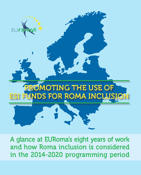24/07/2016
EURoma Technical Secretariat

The European Network on Social Inclusion and Roma under the Structural Funds (EURoma Network) releases its final report of the 2007-2013 programming period ‘Promoting the Use of ESI Funds for Roma Inclusion. A glance at EURoma’s eight years of work and how Roma inclusion is considered in the 2014-2020 programming period’. The report aims to review how fourteen countries currently involved in the Network consider Roma inclusion in the Operational Programmes adopted for the 2014-2020 European Structural and Investment (ESI) Funds programming period. It also provides a glance at EURoma’s trajectory, main products and overall added value and impact during its eight years of operation.
The European Network on Social Inclusion and Roma under the Structural Funds (EURoma Network) releases its final report of the 2007-2013 programming period ‘Promoting the Use of ESI Funds for Roma Inclusion. A glance at EURoma’s eight years of work and how Roma inclusion is considered in the 2014-2020 programming period’.
The report has a two-fold objective:
It is expected that the mutual learning and common reflection on the work of EURoma and on the state-of-play and crucial aspects for the implementation of the ESI Funds in the 2014-2020 programming period will contribute to achieving the most efficient use of these funds for the inclusion of vulnerable groups, including Roma, in the coming years.
The current programming period should serve to take the definite step forward in promoting a real change in the lives of the many European Roma that still today suffer from poverty, exclusion and discrimination. We should not miss the opportunity offered by the new ESI Funds Regulations, which open up a wide range of possibilities for promoting the social inclusion and non-discrimination of Roma, including, but not exclusively, within the explicit ESF Investment Priority ‘Socio-economic integration of marginalised communities such as the Roma’ (IP 9.2.). The framework for transnational cooperation and initiatives such as the EURoma Network can also largely contribute to fostering an effective use of ESI Funds for Roma inclusion.
Led by the Spanish ESF Managing Authority (Ministry of Employment and Social Security) and with the Fundación Secretariado Gitano (FSG) as Technical Secretariat, EURoma aims to promote the use of Structural Funds for the inclusion of the Roma population and as a result enhancing the effectiveness of policies targeting the Roma community. To this end, it gathers public bodies responsible for Structural Funds (notably ESF Managing Authorities or delegated Intermediate Bodies/Implementing Authorities) and for the policies targeting the Roma population (notably the National Roma Contact Points) from fifteen Member States: Austria, Belgium, Bulgaria, Croatia, Czech Republic, Finland, Greece, Hungary, Italy, Poland, Portugal, Romania, Spain, Slovakia and Sweden. The Network Technical Secretariat is hosted by the Fundación Secretariado Gitano (FSG).
Over its eight years of operation, EURoma has become a fundamental actor and a forum of reference at European level as regards the inclusion of Roma population and Structural Funds. Throughout the 2007-2013 programming period, it has worked to promote the effective implementation of the actions planned in this period and to foster advances in the planning of the 2014-2020 period. To this end, it has encouraged mutual learning and capacity building of key actors, knowledge generation and provision of support to address crucial aspects for the effective use of the funds. EURoma has been one of the most active transnational networks but also been highly valued by relevant actors for Roma inclusion and Structural Funds, including European institutions, European and international organisations and networks and civil society organisations.
It is encouraging to see that in the programming documents for the 2014-2020 ESI Funds programming period increased attention is paid to Roma inclusion, with Roma people and Roma communities targeted to a large extent and in a broad number of Operational Programmes (OPs), going beyond the ESF and in particular the specific Investment Priority 9.2. There are also plans to make progress in some of the areas that represented the biggest challenges in the 2007-2013 programming period such as the use of different funds, the combination of these funds, the incorporation of Roma inclusion at different levels or the coverage of different areas of intervention.
Now it remains to be seen how this positive framework and the different options selected by countries in terms of scope (national or regional OPs), funds (European Social Fund, European Regional Development Fund or others), thematic objectives and Investment Priorities (9.2. or others), approaches (explicit mention, no mention and territorial approaches), hierarchical importance given to actions targeting Roma (at the level of priority axes, specific objectives or actions) and fields of Intervention are translated into practice in the implementation phase.
Building upon the analysis made and the experience from the 2007-2013 programming period, the following aspects should be considered during the implementation phase:
In order to assure the effective incorporation of Roma within ESI Funds, it is essential that all these elements are assumed not only by national Operational Programmes but also by regional ones, which should fully develop their potential in this programming period.
This report has been edited and distributed with the support of the ESF and the Fundación Bancaria "La Caixa". 
Links